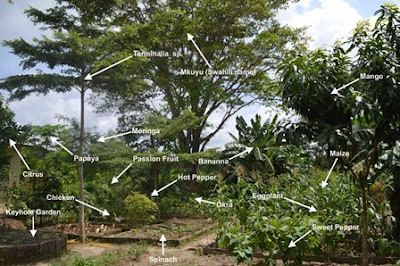PDC LESSON 2.44 DESIGN - Food Forest Garden
PERMACULTURE COURSE AGRO-ECONOMY
PDC LESSON 2.44 DESIGN - Food Forest
Garden
Food Forest
gardening is a central practice of Permaculture and is an ecological design
strategy for sustainable living.
Eco systems such as mature rain forests have a huge number of relationships between its component parts. Trees, understory, ground cover, soil, fungi, insects and animals are an integral part of this system. Plants grow at different heights, and this allows a diverse community of life to grow in a relatively small space. Plants come into leaf and fruit at different times of year.
Edible forest gardens can mimic the complexity of a mature ecosystem and can offer inspiring and practical information of perennial polycultures and of multipurpose plants in small-scale settings. We can apply the principles of a natural ecology to the design of home gardens that mimic forest ecosystems to grow our food, fuel, fodder, fertiliser, ‘farmaceuticals,’ and fun. We should begin to learn how to apply ecological principles to the design of our food production systems and learn about the complex laws of nature. We can learn this through designing and creating a food forest garden. It will be like an outdoor classroom.
Food forest gardening is also known as three-dimensional gardening. It is a food production and land management system based on replicating woodland ecosystems, but substituting trees with large bushes, shrubs, herbs, vines and vegetables which have yields useful to humans and livestock. By the use of support plants, guilds and companion plants, these can be intermixed to grow on multiple levels in the same area amongst the tropical vegetables, as do the plants in a forest. Based on the observation that the natural forest can be divided into distinct layers or ‘stacking,’ we use inter-cropping to develop a food forest garden.



Comments
Post a Comment